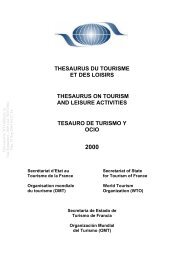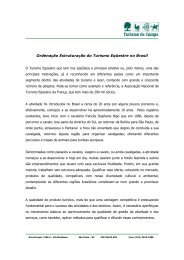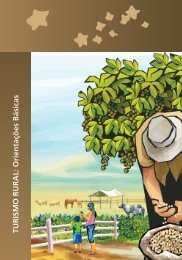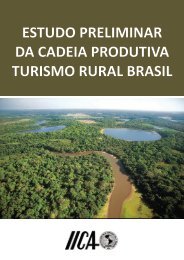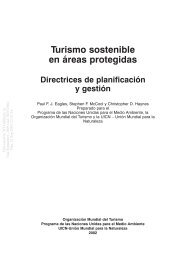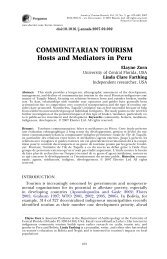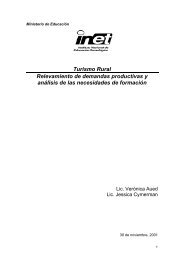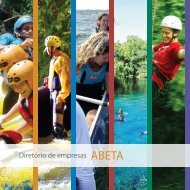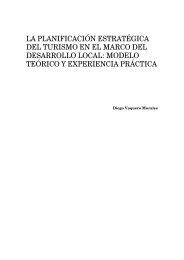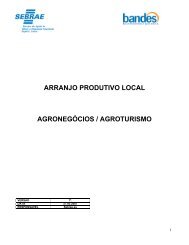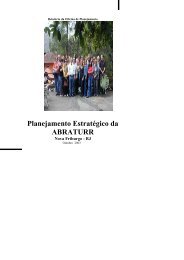TOURISM AND RURAL SETTLEMENTS Nepal's ... - ResearchGate
TOURISM AND RURAL SETTLEMENTS Nepal's ... - ResearchGate
TOURISM AND RURAL SETTLEMENTS Nepal's ... - ResearchGate
Create successful ePaper yourself
Turn your PDF publications into a flip-book with our unique Google optimized e-Paper software.
Annals of Tourism Research, Vol. 34, No. 4, pp. 855–875, 2007<br />
0160-7383/$ - see front matter Ó 2007 Elsevier Ltd. All rights reserved.<br />
Printed in Great Britain<br />
www.elsevier.com/locate/atoures<br />
doi:10.1016/j.annals.2007.03.012<br />
<strong>TOURISM</strong> <strong>AND</strong> <strong>RURAL</strong> <strong>SETTLEMENTS</strong><br />
Nepal’s Annapurna Region<br />
Sanjay K. Nepal<br />
Texas A&M University, USA<br />
Abstract: Functional and humanist perspectives relevant to counterurbanization studies are<br />
applied to examine the processes of growth and development of rural settlements affected by<br />
tourism. Based on a survey of tourism lodges located in several settlements in the Annapurna<br />
region of Nepal, this paper analyzes tourism-induced growth in such accommodations and its<br />
implications on changing characteristics. Results suggest the emergence of a hierarchical<br />
structure of rural settlements with core and peripheral traits. A normative classification of<br />
induced patterns defined by their development stage, size, and function is proposed. Historical,<br />
social, and economic influences on the transformation of rural settlements are discussed.<br />
Keywords: counterurbanization, functional perspective, humanist perspective, lodges, rural<br />
settlements, normative classification. Ó 2007 Elsevier Ltd. All rights reserved.<br />
Résumé: Tourisme et zones résidentielles rurales: la région Annapurna au Népal. On applique<br />
des perspectives fonctionnelles et humanistes pertinentes aux études de la contre-urbanisation<br />
pour examiner les processus de croissance et de développement des zones<br />
résidentielles rurales affectées par le tourisme. Basée sur une enquête des gîtes de tourisme<br />
dans plusieurs zones résidentielles dans la région Annapurna du Népal, l’article analyse la<br />
croissance provoquée par le tourisme dans ce genre de logement et les implications pour<br />
les caractéristiques changeantes. Les résultats suggèrent l’émergence d’une structure hiérarchique<br />
des zones résidentielles rurales avec des caractéristiques fondamentales et périphériques.<br />
Une classification normative des modèles intentionnels selon leur étape de<br />
développement, ampleur et fonction est proposée. On discute des influences historiques,<br />
sociales et économiques sur la transformation des zones résidentielles rurales. Mots-clés: contre-urbanisation,<br />
perspective fonctionnelle, perspective humaniste, gîtes, zones résidentielles<br />
rurales, classification normative. Ó 2007 Elsevier Ltd. All rights reserved.<br />
INTRODUCTION<br />
Geographical perspectives on the patterns of development of tourism<br />
attractions and destinations have taken many different dimensions.<br />
Volumes have been written on the evolutionary models, including the<br />
widely popular lifecycle concept and its implications for destinations at<br />
each phase (Agarwal 2001; Butler 1980; Papatheodorou 2004). Traditional<br />
approaches to studying have included core and peripheral structures<br />
(Brown and Hall 2000; Christaller 1963; Zurick 1992), the<br />
Sanjay Nepal is Assistant Professor at the Department of Recreation, Park and Tourism<br />
Sciences at Texas A&M University, College Station TX 77845-2261. Email ).<br />
Trained in geography and planning, his research interests include the<br />
dynamics of conflicts between local communities and protected area agencies, participatory<br />
conservation of such areas, and environmental impacts of tourism. His current research focus<br />
is on impacts in mountainous regions of Canada, Nepal, and Thailand.<br />
855
856 <strong>RURAL</strong> <strong>SETTLEMENTS</strong><br />
morphology of attractions, destinations, and specialized resorts (Jansen-Verbeke<br />
1986; Leiper 1990; Pearce 1999), and the forms, functions,<br />
and expansion of resorts (Mathieson and Wall 1982; Pearce<br />
1978). More recently, the evolution of self-contained holiday villages<br />
and second homes is a topic of growing interest (Faché 1995; Hall<br />
and Müller 2004). However, Pearce (1999) has lamented that the spatial<br />
structure of tourism has essentially ignored processes and phenomena<br />
at localized scales. This well applies to rural regions, where at local<br />
and regional scales, the spatial arrangements of attractions have been<br />
researched very little. Moreover, studies on change in spatial characteristics<br />
of bucolic settings at both local and regional scales tend to be<br />
unsupported by extensive theoretical basis, as, Pearce (1995) asserts,<br />
has happened in the context of urban attractions. According to him,<br />
this requires drawing upon literature outside tourism: from the context<br />
of rural regions (the focus of this study), from rural studies, and particularly<br />
from research in counterurbanization.<br />
The changing relationships between urban and rural areas have<br />
been argued to be the products of restructuring and alignment of<br />
post-industrial production and consumption activities (Dahms and<br />
McComb 1999). These changes are manifested in the growth and redistribution<br />
of housing and settlement patterns (Kuentzel and Ramaswamy<br />
2005), and a realignment of bucolic space to accommodate the<br />
expanding service sector (Butler, Hall and Jenkins 1998). The interests<br />
in changing rural–urban relations have thus become a topic of<br />
renewed interest to many geographers, economists, sociologists, and<br />
urban and regional planners. Similarly, the spatial patterns of areal<br />
organization of settlements (Schnaiberg, Riera, Turner and Voss<br />
2002), and the evolution, appearance, and perceptions of regions’ distinctive<br />
cultural landscapes (Gude, Hansen, Rasker and Maxwell 2005)<br />
are topics of growing interest. Complementarily, a growing body of literature<br />
exists on counterurbanization and its effects on rural redistribution<br />
of population, housing, and changing patterns of human<br />
settlements (Dahms 1998). Counterurbanization has been defined at<br />
least in two ways: as a movement of people from urban to bucolic areas<br />
and as a change in settlement system (Mitchell 2004). One consequence<br />
of this phenomenon is that many areas are experiencing a transition<br />
from agrarian- to service-based industries, with dramatic effects<br />
on landscapes. While rural amenity attractions and touristic landscapes<br />
have been a topic of interests to many (Butler et al 1998), literature on<br />
tourism-induced settlement growth patterns and changing functional<br />
characteristics is scant. This paper aims to address this shortcoming.<br />
While counterurbanization studies are mainly concerned about the<br />
consequences of urban–rural movements, it is argued that the effects<br />
of international tourism in such destinations in the Third World are<br />
similar to that of counterurbanization effects in the developed West,<br />
where rural areas have seen rapid changes in their economy and settlement<br />
patterns. In the context of settlements, Mitchell has stated that<br />
the focus of counterurbanization studies shifts from ‘‘a migratory movement<br />
to one of a process of settlement system change...’’ (2004:18; italics<br />
in original). The emphasis on process implies that this must be exam-
SANJAY NEPAL 857<br />
ined from both functional and humanist perspectives. While the former<br />
offer explanations to how settlements evolve, expand, and take<br />
certain spatial and morphological forms (Cowie 1983), the latter enhance<br />
the understanding of complex social, political, and economic<br />
processes which influence the emergence and development of settlements<br />
(Spencer 1995). This study is about such processes, which are<br />
analyzed and explained through a combination of the functional<br />
and humanist perspectives, but in the context of tourism development.<br />
In particular, this study examines the processes of growth and distribution<br />
of accommodation lodges; the relationship between tourism infrastructure<br />
and settlement development patterns; the progression<br />
toward a hierarchical development and classification; and the historical<br />
and social factors in tourism-induced rural settlement development<br />
patterns.<br />
PERSPECTIVES TO <strong>RURAL</strong> <strong>SETTLEMENTS</strong><br />
Counterurbanization studies have progressed from their traditional<br />
functional view (forms, patterns, and shapes) to humanist interpretations<br />
of historical, political, social, and cultural factors that shape the<br />
arrangement and rearrangement of rural settlements systems. The<br />
functional perspectives have included the analysis of deconcentration<br />
of people and houses in bucolic areas, increase in number of dwellings,<br />
dispersal patterns of dwellings, areal differentiation, and hierarchical<br />
structures. The humanist perspectives have provided critical explanations<br />
as to why these patterns have emerged and in what ways people’s<br />
attitudes, decisionmaking behaviors, historical precedents, and political<br />
and social factors influence settlement patterns. The following<br />
review of the functional and humanist perspectives in counterurbanization<br />
studies attempts to illustrate their application to the processes of<br />
changes brought about by international tourism.<br />
Functional Perspectives<br />
While settlements have also been conceived as a product of adaptation<br />
to environmental conditions (Allen 1997), early research has focused<br />
on their role as central places, or as nodes of retail<br />
distribution. The classic spatial location theories of Christaller, Losch<br />
and Isard analyzed the size, spacing, and distribution of settlements<br />
as a result of their utilization of microeconomic theoretical principles<br />
(Harvey 1969 cited in Cowie 1983). Cowie (1983) argues that original<br />
central place theory has avoided the conceptual problems posed by the<br />
geographic characteristics of rural regions by incorporating these<br />
nodes into its assumptions. The classic models thus offer limited explanations<br />
to assessing the spatial characteristics of the very smallest settlements,<br />
or as what Haggett (1965 cited in Cowie 1983) has referred to as<br />
the lower limb. Similarly, Cowie (1983) argues that studies which have<br />
attempted to apply concepts compatible with classical analysis to
858 <strong>RURAL</strong> <strong>SETTLEMENTS</strong><br />
low-order areas have not considered the influence of political, social,<br />
and cultural forces on their size, shape, and distribution.<br />
Critics of spatial location theories have considered counterurbanization<br />
as a valid alternative that more appropriately explains the growth<br />
and change in population and settlement patterns in the lower hierarchies<br />
(Dahms and McComb 1999; Spencer 1995). A primary consideration<br />
of counterurbanization includes the deconcentration of people<br />
from cities to rural areas (Berry 1976), taking the form of an inverse<br />
relationship between the population size and its rate of growth (Champion<br />
1989). For many researchers, it is simply an issue of human migration<br />
from denser cities to peripheral and rural settings where the<br />
abundance of land is a primary attraction (Stockdale, Findlay and Short<br />
2000). Still others define it as some aspects of change in the settlement<br />
system, from densely compacted urban systems to deconcentrated patterns,<br />
where the scale and the spatial unit is at a much lower hierarchy<br />
(Spencer 1995). Mitchell (2004) states that counterurbanization is<br />
viewed as a process of change giving rise to a deconcentrated settlement,<br />
and raises the question of whether it should be construed as a<br />
movement, a process, or a pattern. Explanations as to what triggers<br />
counterurbanization are numerous: structural changes in national<br />
and international economies (Bolton and Chalkey 1990), attraction factors<br />
such as environmental amenities (Shumway and Otterstrom 2001),<br />
appeal of better environment and a tranquil lifestyle (Halliday and<br />
Coombes 1995), place utility (Sant and Simmons 1993), the rising<br />
importance of service sectors rather than manufacturing (Frey 1993),<br />
and commodification of rurality (Grieve and Tonts 1996). One significant<br />
process, which has intensified after the 90s, is the rise in demand<br />
for tourism and amenity migration in rural and countryside areas (Hall<br />
and Müller 2004). This demand has fuelled a rural service industry that<br />
continues to shape and reshape rural landscapes, land uses, housing<br />
and mobility patterns, and production of a countryside that is increasingly<br />
looking urban in character and sophistication. The effects of<br />
counterurbanization include permanent movement of people away<br />
from urban cities, contributing to the increase in number of rural dwellings,<br />
their dispersal patterns, areal differentiation, and the emergence<br />
of hierarchical deconcentrated settlement systems (Spencer 1995).<br />
These effects are similar to the effects of tourist flows in rural regions<br />
where despite the temporary nature of the surge, the number of permanent<br />
dwellings continues to increase. The new dwellings are either second<br />
homes or tourism accommodations. This increase in this housing<br />
and related infrastructure has produced settlement patterns that are<br />
dominated by tourism development. However, this phenomenon has<br />
not been studied well. Not much is known about the underlying processes<br />
and outcomes of the resulting growth and distribution patterns.<br />
Humanist Perspectives<br />
Three underlying themes that provide humanist perspectives on<br />
counterurbanization studies include change, process, and space.
SANJAY NEPAL 859<br />
Brown (1999) has argued that change as a research topic should exist<br />
in its own right. The analysis of tourism-induced rural housing and settlements<br />
thus can be viewed from the perspective of change, which is<br />
associated with processes or vice versa. Orjan (1999) has stated that a<br />
proper understanding of the recent past is essential to comprehend<br />
emerging patterns and processes. Inherent in these processes are a<br />
multitude of decisionmaking behaviors of various actors, resulting in<br />
a highly complex characterization of development process (Brown<br />
1981), largely attributed to the interaction among social and economic<br />
activities, physical ecological units, and development plans carried out<br />
in any given region. This interface, although nonlinear and dynamic,<br />
often produces a self-organized system. Historically, this has been the<br />
case for urban growth processes (Allen 1997), and today it can be related<br />
to growth processes in rural areas too. Cowie’s (1983) critique<br />
that the classic central place theories do not consider the political,<br />
social, and cultural factors in growth processes is a valid one. However,<br />
there is a growing body of literature that incorporates humanistic perspectives<br />
of development processes, for example, the changing functional<br />
roles of bucolic settlements as influenced by perceptions and<br />
decisionmaking by inhabitants (Spencer 1995). In the context of tourism,<br />
Butler and Clark (1992) also have argued for more systematic and<br />
indepth research on the relationship between the uneven social composition<br />
of rural areas, the spatially variable development of tourism,<br />
and the problematic relationship between the two.<br />
A second underlying theme is that of process, a sequence of changes<br />
in space and time (Cheng and Masser 2004). An understanding of<br />
change through both time and space should theoretically lead to an improved<br />
understanding of change and of the processes driving it (Gregory<br />
2002). A spatial process, however, is much more than a sequence of<br />
changes, and implies a logical sequence of events being carried out in<br />
some definite manner that lead to a recognizable result (Getis and<br />
Boots 1978). Change is defined by a series of patterns, and logical sequence<br />
implies an understanding of process. In contrast to pattern, process<br />
contains a dynamic component. In the context of rural settlements,<br />
it is imperative that both change and its processes are determined so<br />
that any undesirable alterations and processes therein can be minimized<br />
in the future. A third underlying theme is that of touristic space.<br />
The transformation of space often comprises complex, intertwined linkages<br />
of social, economic, and political space, as Torres and Momsen<br />
(2005) discuss in their study of Cancun, Mexico. Space can be differentiated<br />
in many ways: as an empty area which is merely a nonplace notion<br />
of placelessness, as an in-between tourism place where lines are blurred<br />
between travelling, dwelling, and other social behaviors, as an enclavic<br />
exclusively for the consumption of a tourism class (Place 1995), and as a<br />
hybrid development marked by irregularities (Torres and Momsen<br />
2005). The effects of tourism on space thus greatly vary across a region,<br />
producing a variable mosaic of space and landscapes.<br />
The discussion of functional and humanist perspectives is applied in<br />
this study of tourism-induced changes in the form, functions, and hierarchies<br />
of rural settlements in Nepal’s Annapurna region. Analysis is
860 <strong>RURAL</strong> <strong>SETTLEMENTS</strong><br />
based on two key questions: whether tourism-induced rural settlement<br />
systems exhibit patterns similar to the effects (growth, distribution,<br />
hierarchy) of counterurbanization and whether these effects can be<br />
meaningfully interpreted using humanist perspectives of change and<br />
processes discussed in the context of counterurbanization.<br />
Study Methods<br />
Results presented in this paper are based mainly on a questionnaire<br />
survey of 497 lodge owners, locally available documents on economic<br />
development trends, and published accounts of social and economic<br />
conditions in the region. Fieldwork, conducted during the four<br />
months between May and August 2002, included visiting 100% of the<br />
lodging establishments in 94 settlements. Onsite interviews with owners<br />
were conducted using a checklist of items which solicited information<br />
on the name of the property, location (including altitude), year of<br />
establishment, type of settlement, history of construction (i.e., new<br />
construction mainly for the purpose to use as a lodge or conversion<br />
of a pre-existing dwelling to one). Further, sought information included<br />
number of single, double, triple rooms, and dormitories, total<br />
number of beds, average room occupancy, number and type of toilets<br />
(attached/detached) and shower rooms (hot shower or not), and future<br />
plans for expansion. The checklist also contained information<br />
on owners’ primary and secondary occupation, ethnicity, approximate<br />
number of guests per day during tourism seasons (March–May and<br />
October–November), ownership information (own/rent), and number<br />
of employees (including hired labor from outside the family). Additional<br />
data were gathered through discussion with local people and<br />
other key informants, including local officials, schoolteachers, trekking<br />
guides, and porters. Informal conversations with guests, especially<br />
repeaters, were also useful in examining some of the changes. Because<br />
socioeconomic information on each village where the lodges were located<br />
was necessary to provide adequate context for development<br />
through time, secondary information sources (mostly in Nepali) were<br />
collected from five local administrative district headquarters in Pokhara,<br />
Beni, Jomsom, Chame, and Besisahar. Historical accounts of<br />
trade and tourism and other aspects of social and economic systems<br />
in the region are based on existing literature.<br />
A second purpose of the survey was to apply a normative classification<br />
scheme to the various types of settlements influenced by tourism.<br />
This was based on settlement records (old or new), history of lodges,<br />
number of lodges and their sizes (rooms and beds), type of economic<br />
function (degree of dependency on tourism or agriculture), degree of<br />
local involvement in tourism, and locational advantages (from a tourism<br />
standpoint) of the settlements. Based on the above and additional<br />
background information related to this history, demographics, and<br />
economics, a five-class system of settlements was developed. After analyzing<br />
the data, all were assigned to a class based on the above criteria<br />
and after cross-checking existing backgrounds available. The validity of
SANJAY NEPAL 861<br />
Figure 1. Major Settlements in the Annapurna Region<br />
the classification system was checked in two ways: one, correlations tests<br />
to examine if older settlements had proportionately more lodges and<br />
local employment in tourism compared to newer ones, and two, the<br />
fit of the classification was verified qualitatively from discussions with<br />
local lodge owners and key informants during a follow-up visit in summer<br />
2003. Data were coded and entered into the SPSS database (SPSS<br />
v. 12.0). Results are mainly descriptive, with the intention to provide an<br />
analysis of key processes of tourism-induced growth and distribution,<br />
and changes in settlement functions. Where appropriate, the results<br />
of Pearson’s chi square (X 2 ) and correlation (r) tests are discussed. Reported<br />
significance values are at a 0.05, unless otherwise indicated.<br />
Tourism and Rural Settlements in Annapurna<br />
Located in the western region of Nepal, the Annapurna Conservation<br />
Area is the most popular international trekking destination in this<br />
country (Figure 1). Its 7,629 km 2 area consists of high mountain scenery,<br />
more than 300 km of trail network through high passes, deep
862 <strong>RURAL</strong> <strong>SETTLEMENTS</strong><br />
Number of Permits ('000)<br />
90<br />
80<br />
70<br />
60<br />
50<br />
40<br />
30<br />
20<br />
10<br />
0<br />
1980<br />
1981<br />
1982<br />
1983<br />
(Source: HMG 2003)<br />
1984<br />
1985<br />
1986<br />
1987<br />
1988<br />
1989<br />
1990<br />
1991<br />
1992<br />
Year<br />
1993<br />
1994<br />
1995<br />
1996<br />
1997<br />
1998<br />
1999<br />
2000<br />
2201<br />
2002<br />
2003<br />
Figure 2. Number of Trekking Permits issued in the Annapurna Region<br />
gorges, fast flowing rivers, and colorful settlements. Tourism and environmental<br />
management in the region are regulated by the Annapurna<br />
Conservation Area Project, which is an undertaking of the King Mahendra<br />
Trust for Nature Conservation (recently renamed the National<br />
Trust for Nature Conservation), a nongovernmental organization. Various<br />
ethnic groups including the Gurung, Magar, Thakali, Manangi,<br />
Brahmin, Chetri, and Newar inhabit the region. In the past, declining<br />
trade and deteriorating agricultural productivity in the central hills of<br />
Nepal had caused an exodus of people to the lowlands, as new frontiers<br />
were opened for resettlement. With the rise in tourism in the early 80s,<br />
many families returned to their original homes to invest in related businesses<br />
(Heide 1988). Figure 2 gives the annual number of trekking permits<br />
issued since 1980. It shows that the numbers have increased from<br />
14,332 in 1980 to 35,800 in 1990, and, by 2000 to more than 65,000; but<br />
the numbers have declined since then due to political turmoil in the<br />
country (Bhattarai, Conway and Shrestha 2005). Trekking tourism,<br />
concentrated along three main routes including Jomsom, Manang,<br />
and Annapurna Base Camp (ABC), has become a major economic<br />
activity in the region. It provides employment to over 50,000 local<br />
guides, porters, and entrepreneurs.<br />
Growth and Distribution of Lodges. The first lodge in the region was<br />
opened in 1969, but by 1980 there were 45 already, which increased<br />
to 203 in 1990 and 497 in 2002. Until 1990, only 29 settlements had<br />
lodges and by 1990 this was 69; by 2002 there were 94 with at least<br />
one lodge. Growth in the number of properties corresponds to increases<br />
in number of trekkers. A comparison of increase in the three<br />
regions shows that until 1980 development was concentrated mainly<br />
in Jomsom. Significant growth in their numbers continued there during<br />
1980–90; however, ABC and Manang also saw dramatic increases;<br />
the former surpassed Jomsom in lodge construction during this period<br />
(Table 1). This pattern continued well into 1995, after which Manang<br />
saw a dramatic surge in construction, closely followed by Jomsom.<br />
Overall, Jomsom has more older (>20 years) lodges (8.1%), compared<br />
to ABC (4.9%) and Manang (4.6%): 44% of the units in Manang are<br />
less than five years old, compared to Jomsom (36.8%) and ABC<br />
(31.4%). However, differences across the three routes are statistically<br />
not significant (X 2 = 62.562, p < .109).
SANJAY NEPAL 863<br />
Table 1. Growth in Tourist Lodges and Accommodation Capacity<br />
Region 1980 1990 1995 2000 Total a<br />
ABC<br />
Lodge 9 56 44 36 145<br />
Bed 191 971 708 504 2,374<br />
Bed/Lodge 21.2 17.3 16.1 14.0 16.4<br />
Jomsom<br />
Lodge 24 51 42 70 187<br />
Bed 710 1,002 681 988 3,381<br />
Bed/Lodge 29.6 19.6 16.2 14.1 18.1<br />
Manang<br />
Lodge 9 42 34 72 157<br />
Bed 208 888 793 1,149 3,038<br />
Bed/Lodge 23.1 21.1 23.2 15.9 19.3<br />
a Not including eight surveyed lodges for which information on bed capacity was missing.<br />
Similar growth can be observed in total number of beds added during<br />
different periods. Interesting, however, is the ratio of bed and<br />
lodge, which appear to decline after 1990 except in Manang, where<br />
it increased until 1995 then declined. There are more bigger lodges<br />
(>21 beds/lodge) in both Jomsom (30.2%) and Manang (31.4%) than<br />
in ABC (22.6%). Conversely, ABC has many smaller lodges (
864 <strong>RURAL</strong> <strong>SETTLEMENTS</strong><br />
7.0<br />
Growth (%)<br />
6.0<br />
5.0<br />
4.0<br />
3.0<br />
Until 1990<br />
1991-1995<br />
After 1995<br />
2.0<br />
1.0<br />
0.0<br />
Besisahar<br />
Jagat<br />
Tal<br />
Dharapani<br />
Chame<br />
Manang and Braga<br />
Muktinath<br />
Jomsom<br />
Kagbeni<br />
Settlement<br />
Kalopani-Lete<br />
Ghara-Sikha<br />
Ghorepani<br />
Ghandruk<br />
Chomrong<br />
Landruk<br />
Dhampus<br />
Figure 3. Growth in Lodges in Selected Settlements<br />
is 18.6 compared to 9.1 in those without it. Also, room occupancy is<br />
higher in the former (42.6%) than in the latter types (39.5%).<br />
Figure 3 compares the growth in lodges in selected settlements.<br />
Their main concentrations (in Ghorepani, Ghandruk, Dhampus, Manang<br />
Muktinath, Jomsom, and Kagbeni) constitute 21.1% of all units in<br />
the region. Three ABC settlements (Ghorepani, Ghandruk, and Chomrong)<br />
together make up 10.5% of all in the region, but their proportional<br />
share has declined since 1990. Overall, growth in bigger<br />
settlements has slowed down, with the implication that the accommodation<br />
capacity there has reached its peak. As a consequence, Dharapani,<br />
Chame, Kalopani-Lete, and Ghara-Sikha have seen more<br />
growth in recent years.<br />
Toward a Normative Classification. Overall, rural settlements in the<br />
Annapurna region can be grouped into five types. Type I usually have<br />
numerous lodges (minimum of 10), high capacity (>200 beds in total),<br />
a few grocery stores, access to electricity, one or two video outlets, and a<br />
dominant tourism-driven economy. They are also the main centers<br />
where most government offices, including those related to tourism<br />
(telephone, foreign exchange, and information services), are located.<br />
Type II are bigger (in total number of housing units) but generally<br />
have less than 10 lodges, less than 120 beds, and a rudimentary infrastructure<br />
compared to the former type. Lodging and tourism services<br />
are not the most important activities in this group. The next types<br />
are strategically located, bigger in size, and mostly at higher altitudes;<br />
they are fully dependent on tourism. Type IV have experienced a transition<br />
from a seasonal to permanent habitation and are now completely<br />
dependent on tourism. Similar to Type III, the last type are strategically<br />
located but smaller settlements dependent entirely on tourism. The<br />
distribution of number of lodges by settlement types is shown on Table<br />
2. There are 12, 30, 28, 7, and 17, respectively, in the five type settle-
SANJAY NEPAL 865<br />
Table 2. Classification of Settlement Types in the Annapurna Region<br />
Type Lodge (f) Region Settlement (year when the first lodge opened)<br />
I<br />
II<br />
III<br />
IV<br />
V<br />
Established settlement with more than two decades of tourism history<br />
54 ABC Ghandruk (69), Chomrong (73), Dhampus (74), Landruk (74)<br />
76 Jomsom Ghorepani (72), Marpha (84), Jomsom (74), Kagbeni (74),<br />
Muktinath (74)<br />
34 Manang Besisahar (85), Chame (78), Manang (77)<br />
Traditionally farming village experiencing significant growth in lodging<br />
activities in recent years<br />
22 ABC Chimrong (?), Syauli Bazar (84), Kimche (84), Birethanti (74)<br />
83 Jomsom Sudame (?), Ramghain (?), Ulleri (82), Tikheduga (79),<br />
Hile (84), Sikha (84), Ghara (84), Dana (74),<br />
Pahirothapla (?), Kaiku (?), Ghasa (74), Lete (74),<br />
Kalopani (69), Kobang (79), Larjung (79), Tukuche (74),<br />
Khingar (84)<br />
44 Manang Jharkot (79), Khudi (87), Bahundanda (87), Tal (73),<br />
Pisang (92), Braga (89), Dharapani (83), Timangbesi (?),<br />
Ngawal (?)<br />
Strategic/traditional village that developed as a result of later tourism<br />
53 ABC Tadapani (?), Bamboo (87), Dovan (87), Chitre (82),<br />
Himalaya (84), Deurali (84), Annapurna Base Camp (84),<br />
New Bridge (87), Pothana (82), Tolkha (84),<br />
Jhinudanda (89), Machapuchhre Base Camp (89)<br />
20 Jomsom Eklobhatti (?), Tatopani (73), Nangethanti (?), Banthanti (80),<br />
56 Manang Ngandi (77), Jagat (88), Chyamje (74), Latamarang (79),<br />
Koto (84), Donaque (84), Syange (88),<br />
Munji (97),Bhratang (84), Bhulbhule (83),<br />
Bagarchap (87), Ongde (88)<br />
Seasonal village now permanent because of tourism<br />
11 ABC Bhichuk Deurali (86), Bherikharha (79), Simuwa (88)<br />
15 Manang Gunsang (79),Yakkharka (88),Chauritettar (78),<br />
Thorong Phedi (85)<br />
Primarily tourism village (newer)<br />
6 ABC Sitkyu (?), Kumrong Danda/Khola (94)<br />
13 Jomsom Phalante (96), Kokethanti (95), Kopchepani (89), Rupse (94),<br />
Syang (91)<br />
10 Manang Lilibhir (93), Ghermi (?), Shreechaur (?), Yonphu (?),<br />
Karte (?), Thanchowkbesi (93), Dhukur-Pokhari (?),<br />
Kaniga (97), Sera (96), Talekhu (90)<br />
? = Year of lodge establishment unknown.<br />
ments. The growth trends of lodges in the five types indicate that both<br />
the first and second experienced the highest growth in lodges prior to<br />
and during the 1980–90 period. This slowed down for Type I after<br />
1990, but for the other the slowdown during the 1990–95 period was<br />
compensated by a substantial increase after 1995. Similarly, the number<br />
of lodges in Type III follows a pattern similar to that in the second:<br />
a significant increase during 1980–90, followed by a slowdown during
866 <strong>RURAL</strong> <strong>SETTLEMENTS</strong><br />
1990–95, and increasing again after 1995. In contrast to the first three<br />
types both IV and V had fewer lodges until 1990, but increased significantly<br />
thereafter. The validity of the five-class system can be tested at<br />
least in two ways. First, bigger lodges tend to be in older settlements<br />
(as with Types I and II). Second, correlations between settlement type,<br />
beds, tourists, and room are all negative. Although correlation coefficient<br />
values are not significant, the negative relationship indicates that<br />
the third, fourth, and fifth types have lower numbers of beds. They<br />
have fewer tourists and rooms also, thus validating the classification<br />
based on lodge size. Those receiving higher numbers daily have also<br />
employed more people (r = .597, p = < .001), and tend to be older.<br />
These results validate the classification based on degree of local<br />
involvement and history of lodge establishment.<br />
Based on size, the total number of lodges, type of economic base,<br />
number of housing units and population, and degree of local involvement<br />
in tourism, rural settlements in Annapurna can be further<br />
grouped into four categories: core and peripheral; first, second and<br />
third order; tourism either as a primary or secondary activity; and older<br />
and newer. The first two types can be defined as core while the other<br />
three are peripheral. Roughly 63% of all lodges are within the core and<br />
the remaining within peripheral settlements. Type I and II are first order<br />
(rank) settlements given their size of resident and visiting populations.<br />
Types III and IV are of the second and Type V of the third order<br />
hierarchy. Type I, III, IV and V are heavily dependent on tourism, and<br />
the remaining one on agriculture with tourism as a secondary activity.<br />
A Type II reflects a transient economy, that is, from farming to a mixed<br />
economy, while a Type IV suggests its conversion from a seasonal to a<br />
permanent settlement. Similarly, the first two types are older than the<br />
other three. Tourism linkages between Type I, II, III and IV are primary,<br />
while between the first two the linkage is secondary. Type I settlements<br />
like Ghorepani, Jomsom, Muktinath, Ghandruk, Chomrong,<br />
and Landruk have reached their peak in lodge construction; as a result,<br />
there is more construction in the next three types. Trends in lodge<br />
development in Type II indicate that although these settlements experienced<br />
tourism development as early as the first, it is only in recent<br />
years that more new lodges were added. Similarly, a period of boom<br />
in lodge construction in Type III occurred in the early 80s, primarily<br />
because of their locational advantages: terminal point (Annapurna<br />
Base Camp), end of a long ascent (Ongde), spaced out at a considerable<br />
distance (typically four to six hours of trekking, as with Tadapani),<br />
or as alternative but less attractive options for overnight stays (such as<br />
Eklobhatti). These locations soon became alternative stops for overnight<br />
stays and drew a large number of arrivals who might otherwise<br />
have stayed in more established settlements. Further spill effects resulted<br />
in the emergence of new settlements, typically in areas which<br />
had locational advantages similar to Type III. For example, Yakkharka<br />
(kharka refers to a pastureland) was a summer herding village until the<br />
late 80s, but is now inhabited even during fall and early winter. A final<br />
development is the emergence of newer settlements (Type V), which<br />
exist solely because of the growing demand for food and overnight
SANJAY NEPAL 867<br />
accommodation. Typically, there may not be more than three or four<br />
permanent building structures, and they are similar to Type III in locational<br />
advantages. These are more common at high altitudes where<br />
trekkers need an extra day or two to recuperate from the constant uphill<br />
climb.<br />
Implications on Settlement Functions. The progression of settlements<br />
from Type I to Type V is typical of changes at the regional level. Significant<br />
changes have also occurred at the level of individual settlements,<br />
where the growth in lodges has occurred mainly in two different ways.<br />
First, there has been rapid expansion, both spatially and in overall increase<br />
in built-up areas. Second, some traditional houses have changed<br />
their utility, as when their owners have converted their houses to accommodate<br />
tourists. This phenomenon is similar to what has happened in<br />
Namche Bazaar in the Everest region (Nepal 2005). Thus, tourism-related<br />
residence conversion is making dramatic changes in the character<br />
of rural settlements like Ghandruk, Ghorepani, Jomsom, and Kagbeni,<br />
where there are clear tendencies for people to abandon their houses in<br />
the center and to construct more spacious buildings on the periphery.<br />
In Chomrong, a new settlement composed mainly of lodges has<br />
emerged above the old village. While built-up areas are now occupying<br />
rice terraces, a side effect of expanding tourism is that many lodge owners<br />
are no longer able to cultivate their farm land, and those who wish to<br />
continue cannot find people willing to work due to declining interest in<br />
agriculture. Working in trekking is less laborious than farming, is more<br />
prestigious, and has bigger rewards. Lodge owners have been encouraged<br />
to plant trees on fallow land, and it is unfortunate that farm produce<br />
like fresh vegetables, milk, and eggs are imported from outside in<br />
large quantities, resulting in significant economic leakages. The lack of<br />
attention to agriculture and other alternative forms of economic activities<br />
illustrates that increased tourism activity and associated development<br />
of lodges and infrastructure have been responsible for a<br />
gradual shift in local perceptions about the economy and importance<br />
attached to different types of economic activities.<br />
The region’s traditional economic base, which is dependent upon resource-intensive<br />
activities like agriculture and forestry, has been gradually<br />
replaced by service-oriented enterprises. Growth in transport and<br />
communication, hotel and catering, travel agencies, rescue clinics,<br />
banking including foreign exchange, information centers, and art<br />
and cultural exhibitions in Ghandruk, Jomsom and Manang, have<br />
made these settlements increasingly urban in character. The emergence<br />
of specialized bakeries, laundry services, video halls, and Internet<br />
cafés has added to the quality and diversity of tourism services.<br />
Similarly, a large number of shops with an impressive range of imported<br />
consumer goods, including mountaineering equipment and<br />
clothing, food, and local and Tibetan curios now serve the burgeoning<br />
tourism population. In 2001, a new five-star hotel was opened in the<br />
outskirts of Jomsom serving upscale tourists to the region. Many lodge<br />
owners wish to expand or improve their current level of services and<br />
facilities. These include adding extra beds and attached bathrooms,
868 <strong>RURAL</strong> <strong>SETTLEMENTS</strong><br />
Table 3. Lodge Owners’ Future Infrastructure Plans a<br />
Plan ABC (n = 146) Jomsom (n = 192) Manang (N = 159)<br />
Additional beds 23.8 17.3 29.0<br />
Additional attached bathrooms 7.9 12.7 3.7<br />
Solar water heater installation 6.3 16.4 18.7<br />
Building repairs 11.1 10.9 13.1<br />
Roof-top or terrace dining 17.5 15.5 14.9<br />
Backboiler installation 1.6 8.2 5.6<br />
Electricity 11.1 4.5 0.9<br />
Oven/Electric water heater 3.2 9.1 0.9<br />
Better toilets/shower 4.8 4.5 12.1<br />
Others 12.7 0.9 1.1<br />
a Figures indicate % of responses.<br />
adding rooftop or terrace dining, better toilets and shower, and various<br />
energy-related installations (Table 3). Expansion of at least 160 beds<br />
was planned in the near future. While big lodges wished to be bigger<br />
and more sophisticated (with flush toilets and Western type loo), smaller<br />
lodges wanted to add showers and attached bathrooms, two basic<br />
but important amenities in the region. Thus, expanding infrastructure<br />
has not only altered the exterior building design and architecture, but<br />
the interiors of many new lodges look completely modern.<br />
Endogenous Processes. The changing forms, functions, and hierarchical<br />
development of tourism-induced rural settlements can be explained<br />
through the examination of historical, socioeconomic, and cultural<br />
developments within the Annapurna region. The historic migration<br />
of the highland ethnic groups from Tibet during the 13th and 14th<br />
centuries, followed by periods of migration of Tibetan refugees in<br />
the 50s who used the routes on their journey to Pokhara, where a refugee<br />
camp had been established by the Nepali government, have had<br />
influences on the spatial distribution of settlements (Hagen 1994).<br />
Remnants of other refugee camps are scattered throughout the region;<br />
these were established to handle increasing numbers of refugee crossing<br />
over to Nepal from Tibet; some camps like Tatopani eventually became<br />
popular tourism locations.<br />
Hospitality traditions in the region date back to several decades before<br />
the arrival of trekking tourism, and trans-Himalayan trading was<br />
instrumental in establishing this tradition. Trading lasted for more<br />
than two centuries, ending around the early 70s, when modern transportation<br />
and trade treaties made it less profitable (Fürer-Haimendorf<br />
1989). The Thakali were skilled traders and innkeepers who controlled<br />
a significant part of the historic salt trade along the Kali Gandaki corridor<br />
(Heide 1988). A network of bhatti (traditional inns), located strategically<br />
along major trading routes and at transhipment points such as<br />
Tukuche and Manang, served food and accommodation needs of tourists<br />
(Nepal, Kohler and Banzhaf 2002). Many early Europeans who<br />
journeyed across the region found shelter at these establishments,
SANJAY NEPAL 869<br />
which were later adapted to meet the demands of a burgeoning trekking<br />
and mountaineering markets. The rise in tourism caused a reverse<br />
migration from the lowlands to the highlands, where people found<br />
lucrative business and employment opportunities in trekking industry.<br />
Soon Ghandruk, Jomsom, and Manang attained the privileged status of<br />
tourism hubs, benefiting from the influx of government and non-governmental<br />
involvement in providing services and employment opportunities.<br />
Examples of the latter type include the Annapurna<br />
Conservation Area Project headquarters and its several field offices<br />
throughout the region and various district-level administrative services<br />
in Besisahar, Chame, and Jomsom. The post-90s saw the emergence of<br />
small tourist settlements; the main centers like Jomsom, Ghandruk,<br />
Ghorepani, Dhampus, and Manang eventually yielded to new centers<br />
at the expanding periphery.<br />
The kinship and clan system prevalent among ethnic groups like<br />
Gurung, Thakali, and Manangi (Heidi 1988; Macfarlane 1976) helped<br />
members strengthen social and economic ties within their clan. Lodge<br />
ownership in the region is limited mainly to a few influential Gurung,<br />
Thakali, and Manangi families, who have been the forerunners of the<br />
trade and trekking, and today are owners of multiple lodges. With savings<br />
from their employment in the Indian and British Gorkha armies<br />
(Macfarlane 1976), many Gurung families invested in lodges. Similarly,<br />
many Thakali families conducted businesses in cities and were already<br />
very rich by local standards. These ethnic groups controlled a large<br />
share of tourism businesses in the region (for example, Gurungs in<br />
southern Annapurna, Thakalis along the Kali Gandaki corridor, and<br />
Manangi in the upper Marsyangdi Valley). Not only decisions on location<br />
of a lodge, accommodation capacity, and range and quality of services<br />
offered are dictated by influential groups of lodge owners, but<br />
significant proportions of tourism-generated wealth and property remain<br />
confined to a few families. For example, most guides will choose<br />
to arrange accommodations for their guests in lodges that belong to<br />
their close relatives. Similarly, more prestigious jobs such as guiding remain<br />
confined within the inner circle of each clan, whereas lower status<br />
jobs (such as working as a porter) are open to people from other<br />
ethnic groups. The net effect of this system is that the distribution of<br />
wealth and property has remained restricted to a few influential<br />
groups, thus widening the gap in social and economic status between<br />
different ethnic groups.<br />
The advent of service-based enterprise has brought a new set of values<br />
and beliefs associated with perceived notions of social and economic<br />
status; and superior abilities in entrepreneurship are<br />
emerging too. This capacity of the local people is exemplified by some<br />
tea and coffee sellers in Thorung La, a high pass (5416 m) that all trekkers<br />
must cross above Thorung Phedi to complete the Annapurna circuit<br />
trek. The climb from Thorung Phedi (phedi refers to the base of a<br />
hill) to Thorung La (la refers to a mountain pass) is a four-hour walk<br />
on knee-deep snow (even during summer), with an elevation gain of<br />
985 meters. Most trekkers start the climb before dawn and some as<br />
early as 2 in the morning. The treacherous and difficult climb to the
870 <strong>RURAL</strong> <strong>SETTLEMENTS</strong><br />
pass is rewarded not only by spectacular views of several high mountains<br />
but also by early morning coffee or tea, thanks to the ingenuity<br />
of local entrepreneurs who arrive at the pass well ahead of the trekkers<br />
to set up a make-shift shop and earn a profit three to four times greater<br />
than at Thorung Phedi. Over time, such make-shift shops transform<br />
into more permanent structures, the numbers of which may increase<br />
quickly to give an appearance of a tourism settlement.<br />
Many local inhabitants have experienced first-hand that investing in<br />
a new lodge or converting their traditional homes to lodges makes a<br />
good business decision. Due to the remote location and locally controlled<br />
tourism, outside investors are few; the new hotel in Jomsom,<br />
which is owned by an influential Nepali from Kathmandu connected<br />
to the royal family, is an exception. However, during the 90s, many local<br />
lodge owners started to seek financial assistance from foreigners,<br />
typically affluent Western tourists and mountaineering guides; at least<br />
10 lodge owners reported having foreign partners. In addition, the<br />
physical changes of rural settlements can be largely attributed to local<br />
owners’ decisions about the location, size, structure, and design of<br />
lodges. In the absence of government-imposed building regulations,<br />
the decisions are influenced by an owner’s social and economic status,<br />
contemporary trends in trekking, and the demand for specific types of<br />
hospitality services. For example, conversion of group sleeping rooms<br />
into double rooms, provision of hot showers, modern bathroom fixtures,<br />
roof-top and terrace dining, landscaped front yard, and installation<br />
of big glass windows that provide panoramic views of the<br />
mountains are largely driven by tourist demands. There have<br />
been changes in lodge architecture and use of construction materials<br />
too. The Manisha Hotel in Ghandruk represents a stark contrast<br />
in architectural style and building materials against mostly mud and<br />
brick houses characteristic of a Gurung house. Overall, room<br />
and bed capacity of a lodge is more regulated in ABC than Jomsom<br />
and Manang, mainly due to the Annapurna Project’s success in enforcing<br />
limits.<br />
CONCLUSION<br />
Since the early 90s, increasing attention has been paid to understanding<br />
local contexts of changes in the characteristics of rural settlements.<br />
Tourism has emerged as a major driving force in their growth<br />
and expansion. Counterurbanization concepts have incorporated tourism<br />
and amenities in their analysis of human population and housing<br />
growth and distribution patterns. These concepts have been used also<br />
to examine the processes of change in rural settlement systems. This<br />
paper argues that the effects of international tourism on a remote<br />
Third World destination are similar to the effects of counterurbanization<br />
in the developed Western countries. Changes in the growth, distribution,<br />
hierarchies, and appearance of settlements in the Annapurna<br />
region are no different than in other areas affected by increased<br />
urban–rural migration.
SANJAY NEPAL 871<br />
This study of the local impact of an international phenomenon<br />
determines the type and level of changes in rural settlements’ distribution<br />
and hierarchies, and provides explanations as to why particular<br />
patterns and trends have emerged. This is done in two ways. First, a<br />
functional perspective to tourism-induced development patterns is provided.<br />
Second, a humanist perspective on how these changes have<br />
been influenced by several endogenous factors is discussed. Traditionally,<br />
rural areas have been perceived to be slow to change, but with<br />
increasing mobility and the influx of tourists, settlements like those<br />
in the Annapurna region are expanding in size and appearing more<br />
modern than in the past. Traditional settlements that were primarily<br />
subsistence-oriented are now gradually adapting to a cash-based, market<br />
economy. Some specific changes in the Annapurna region include:<br />
overall, more built-up areas; settlements physically expanding both vertically<br />
and horizontally; many smaller settlements dominated by lodges;<br />
linear patterns of expansion following the main trekking routes;<br />
settlements emerging as service-oriented more than as agriculture or<br />
trade centers; emergence of a hierarchical structure; bigger, multistoried<br />
houses with very large accommodation capacities; and architectural<br />
(interior and exterior) changes in housing design, and modern<br />
facilities (such as showers, living rooms, and attached bathrooms).<br />
The increases in dwellings, infrastructure development, dispersal pattern,<br />
and the development of settlement hierarchies observed in<br />
Annapurna are similar to the effects of counterurbanization. It is unlikely<br />
that in the absence of international tourist flow to the region,<br />
these settlements would have progressed to the stage where they are today.<br />
The patterns have been influenced by historic and current economic,<br />
social, and political structures. For example, expansion of<br />
lodges during the early periods was influenced more by local landowners<br />
and rich entrepreneurs and their social and political networks, a<br />
finding that is consistent with counterurbanization studies which indicate<br />
how select groups of local landowners are able to influence the social<br />
and political structures that determine how urbanization<br />
progresses in rural areas (Spencer 1995). The post-90s growth patterns<br />
in Annapurna lodges represent a gradual progression toward a free<br />
enterprise system introduced after the democratic changes in the<br />
country in 1990 which restricted the political power of the rural elite<br />
and increased involvement of rural communities in the decisionmaking<br />
processes.<br />
The study proposes a normative classification of tourism-induced<br />
rural settlements based on their history, growth in number and size<br />
of lodges, period of lodge establishment, type of economic dependence,<br />
and location. Furthermore, an asymmetry of core-periphery<br />
configuration of tourism-induced settlements has emerged. At a regional<br />
level, types I and II exhibit characteristics of core; types III, IV and<br />
V can be characterized as peripheral settlements. The progression<br />
from a lower order to a higher order, and from the periphery to core,<br />
is not necessarily linear, as historical precedents, economic imperatives,<br />
cultural traditions, and geographic locations have affected the<br />
growth and distribution of rural settlements. In the Annapurna region,
872 <strong>RURAL</strong> <strong>SETTLEMENTS</strong><br />
historical influences on tourism and hospitality traditions, past and<br />
emerging social norms and networks, new forms of entrepreneurial<br />
drive, and economic importance placed on different means of production<br />
and consumption all help explain how and why particular patterns<br />
and trends have emerged. Past studies have indicated that smaller settlements<br />
eventually yield to larger ones, as the latter extend their influence<br />
much farther away from their centers. Rural settlements in the<br />
Annapurna region seem to indicate a reversal of this pattern, as several<br />
larger centers have yielded to smaller ones, contributing to a well-defined<br />
hierarchical structure. New settlements have emerged where<br />
there were none before; some have ceased to expand due to physical<br />
barriers and changing economic circumstances, while others continue<br />
to expand and mature as important service centers and tourism spaces.<br />
Understanding these processes of change is an important issue for rural<br />
development and tourism planners. However, planning and regulating<br />
the development of human settlements, and housing structure and<br />
designs in the Annapurna region are beyond the control of the local<br />
government. Decisions on accommodation capacity, architecture,<br />
and utility primarily rest with individuals, and tourist preferences play<br />
an important role in such decisions. Given the complexity of social and<br />
economic relations within and between various ethnic communities<br />
and how these relationships play out in the establishment of tourism<br />
services and facilities, there is very little local governments can do to<br />
influence the outcomes. Therefore, how lodge owners’ attitudes and<br />
decisionmaking behaviors, and their social networks both within and<br />
outside the region, continue to influence the emergence of a spatial<br />
template of growth and development of tourism-induced rural settlements<br />
would be an interesting issue for further research. Will the legacy<br />
of the past continue to shape future developments in lodge<br />
distribution and the emergence of hierarchies? What new social, economic,<br />
and political realities will direct and redirect growth patterns<br />
in lodge development and urbanization of rural areas? What criteria,<br />
besides location, are essential for rural settlements within destinations<br />
to trigger the development of infrastructure? What criteria can be used<br />
to measure a ‘‘tourism threshold’’ for rural centers? Finding answers to<br />
these questions is essential for a broader understanding of the implications<br />
of tourism development for rural settlements.<br />
With the rise in Mao insurgency in the region, and the recent bombing<br />
of Annapurna Conservation Area Project headquarters in Ghandruk,<br />
it is uncertain whether tourism will increase; recent numbers<br />
certainly do not look promising. However, with the recent successfully<br />
negotiated agreement between the mainstream political parties and<br />
the Mao insurgency leaders, it is likely that dramatic changes will take<br />
place in local politics and power structures in the Annapurna region<br />
and throughout Nepal. How these changes will influence the development<br />
of tourism in Nepal’s rural areas and what impacts these<br />
will have on settlement growth and development patterns are unclear<br />
at this time, and could be an interesting research agendum in the<br />
future.
SANJAY NEPAL 873<br />
REFERENCES<br />
Agarwal, S.<br />
2001 Restructuring Sea-side Tourism: The Resort Lifecycle. Annals of Tourism<br />
Research 29:25–55.<br />
Allen, P.<br />
1997 Cities and Regions as Self-Organizing Systems: Models of Complexity.<br />
Amsterdam: Gordon and Breach Science.<br />
Berry, B., ed.<br />
1976 Urbanization and Counterurbanization. Beverly Hills: Sage.<br />
Bhattarai, K., D. Conway, and N. Shrestha<br />
2005 Tourism, Terrorism and Turmoil in Nepal. Annals of Tourism Research<br />
32:669–688.<br />
Bolton, N., and B. Chalkey<br />
1990 The Rural Population Turn Around: A Case Study of North Devon. Journal<br />
of Rural Studies 6:29–43.<br />
Brown, F., and D. Hall<br />
2000 Tourism in Peripheral Areas. Clevedon: Channel View.<br />
Brown, L.<br />
1981 Innovation Diffusion: A New Perspective. London: Methuen.<br />
1999 Change, Continuity, and the Pursuit of Geographic Understanding. Annals<br />
of the Association of American Geographers 89:1–25.<br />
Butler, R.<br />
1980 Concept of a Tourism Area Cycle of Evolution: Implications for Management<br />
of Resources. Canadian Geographer 24:5–12.<br />
Butler, R., and G. Clark<br />
1992 Tourism in Rural Areas: Canada and the UK. In Contemporary Rural<br />
Systems in Transition, I. Bowler, C. Bryant and M. Nellis, eds., Economy and<br />
Society (vol. 2) pp. 166–183. Wallingford: CABI.<br />
Butler, R., C. Hall, and J. Jenkins<br />
1998 Tourism and Recreation in Rural Areas. Chichester: Wiley.<br />
Champion, A., ed.<br />
1989 Counterurbanization: The Changing Pace and Nature of Population<br />
Deconcentration. London: Edward Arnold.<br />
Cheng, J., and I. Masser<br />
2004 Understanding Spatial and Temporal Processes of Urban Growth: Cellular<br />
Automata Modelling. Environment and Planning B: Planning and Design<br />
31:167–194.<br />
Christaller, W.<br />
1963 Some Considerations of Tourism Location in Europe: The Peripheral<br />
Regions-Underdeveloped Countries-Recreation Areas. Regional Science Association<br />
Papers 12:513–527.<br />
Cowie, W.<br />
1983 Towards a Normative Concept of Settlements: The Development Process<br />
and Theoretical and Conceptual Problems in the ‘‘Lower Limb’’. Geoforum<br />
14:55–73.<br />
Dahms, F.<br />
1998 Settlement Evolution in the Arena Society in the Urban Field. Journal of<br />
Rural Studies 14:299–320.<br />
Dahms, F., and J. McComb<br />
1999 Counterurbanization, Interaction and Functional Change in a Rural<br />
Amenity Area: A Canadian Example. Journal of Rural Studies 15:129–146.<br />
Faché, W.<br />
1995 Transformations in the Concept of Holiday Villages in Northern Europe.<br />
In Tourism and Spatial Transformations: Implications for Policy and<br />
Planning, G. Ashworth and A. Dietvorst, eds., pp. 109–128. Oxon: CABI.<br />
Frey, W.<br />
1993 The New Urban Revival in the United States. Urban Studies 30:741–744.<br />
von Fürer-Haimendorf, C.<br />
1989 Exploratory Travels in Highland Nepal. New Delhi: Sterling Publishers.
874 <strong>RURAL</strong> <strong>SETTLEMENTS</strong><br />
Getis, A., and B. Boots<br />
1978 Models of Spatial Process: An Approach to the Study of Point, Line and<br />
Area Patterns. Cambridge: Cambridge University Press.<br />
Gregory, I.<br />
2002 Time-variant GIS Database of Changing Historical Administrative Boundaries:<br />
A European Comparison. Transactions in GIS 6:161–178.<br />
Grieve, S., and M. Tonts<br />
1996 Regulation, Land Development and the Contested Countryside: Reflections<br />
on Bridgetown, Western Australia. The New Zealand Geographer<br />
52:18–23.<br />
Gude, P., A. Hansen, R. Rasker, and B. Maxwell<br />
2006 Rates and Drivers of Rural Residential Development in the Greater<br />
Yellowstone. Landscape and Urban Planning 77:131–151.<br />
Hagen, T.<br />
1994 Building Bridges to the Third World. New Delhi: Book Faith.<br />
Hall, C., and D. Müller<br />
2004 Tourism, Mobility and Second Homes. Between Elite Landscape and<br />
Common Ground. Clevedon: Channel View.<br />
Halliday, J., and M. Coombes<br />
1995 In Search of Counterurbanizaton: Some Evidence from Devon on the<br />
Relationship between Patterns of Migration and Motivation. Journal of Rural<br />
Studies 11:433–446.<br />
Haggett, P.<br />
1965 Locational Analysis in Human Geography. London: Edward Arnold.<br />
Harvey, D.<br />
1969 Explanation in Geography. London: Edward Arnold.<br />
von der Heide, S.<br />
1988 The Thakalis of Northwestern Nepal. Kathmandu: Ratna Pustak Bhandar.<br />
HMG<br />
2003 Tourism Statistics. Kathmandu: Ministry of Tourism and Civil Aviation, His<br />
Majesty’s Government of Nepal, Nepal.<br />
Jansen-Verbeke, M.<br />
1986 Inner-city Tourism: Resources, Tourists and Promoters. Annals of Tourism<br />
Research 13:79–100.<br />
Kuentzel, W., and V. Ramaswamy<br />
2005 Tourism and Amenity Migration: A Longitudinal Analysis. Annals of<br />
Tourism Research 32:419–438.<br />
Leiper, N.<br />
1990 Tourist Attraction Systems. Annals of Tourism Research 17:367–384.<br />
Macfarlane, A.<br />
1976 Resources and Population: A Study of the Gurungs of Nepal. Cambridge:<br />
Cambridge University Press.<br />
Mathieson, A., and G. Wall<br />
1982 Tourism: Economic, Physical and Social Impacts. London: Longman.<br />
Mitchell, C.<br />
2004 Making Sense of Counterurbanization. Journal of Rural Studies 20:15–<br />
34.<br />
Nepal, S.<br />
2005 Tourism and Remote Mountain Settlements: Spatial and Temporal<br />
Development of Tourist Infrastructure in the Mt. Everest Region, Nepal.<br />
Tourism Geographies 7:205–227.<br />
Nepal, S., T. Kohler, and B. Banzhaf<br />
2002 Great Himalaya: Tourism and the Dynamics of Change in Nepal. Berne:<br />
Swiss Foundation for Alpine Research.<br />
Orjan, S.<br />
1999 Shortage, Priority and Urban Growth: Towards a Theory of Urbanization<br />
under Central Planning. Urban Study 36:2217–2236.<br />
Papatheodorou, A.<br />
2004 Exploring the Evolution of Tourism Resorts. Annals of Tourism Research<br />
31:219–237.
SANJAY NEPAL 875<br />
Pearce, D.<br />
1978 Form and Function in French Resorts. Annals of Tourism Research<br />
5:142–156.<br />
1995 Tourism Today: A Geographic Analysis (second ed.). Harlow: Longman.<br />
1999 Tourism in Paris: Studies at the Microscale. Annals of Tourism Research<br />
26:77–97.<br />
Place, S.<br />
1995 Ecotourism for Sustainable Development: Oxymoron or Plausible Strategy?<br />
Geo Journal 35:161–173.<br />
Sant, M., and P. Simons<br />
1993 The Conceptual Basis for Counterurbanisation: Critique and Development.<br />
Australian Geographical Studies 31:113–126.<br />
Schnaiberg, J., J. Riera, M. Turner, and P. Voss<br />
2002 Explaining Human Settlement Patterns in a Recreational Lake District:<br />
Vilas County, Wisconsin, USA. Environmental Management 30:24–34.<br />
Shumway, J., and S. Otterstrom<br />
2001 Spatial Patterns of Migration and Income Change in the Mountain West:<br />
The Dominance of Service-based, Amenity Rich Counties. Professional<br />
Geographer 53:492–502.<br />
Spencer, D.<br />
1995 Counterurbanisation: The Local Dimension. Geoforum 26:153–173.<br />
Stockdale, A., A. Findlay, and D. Short<br />
2000 The Repopulation of Rural Scotland: Opportunity and Threat. Journal of<br />
Rural Studies 16:243–257.<br />
Torres, R., and J. Momsen<br />
2005 Gringolandia: The Construction of a New Tourist Space in Mexico. Annals<br />
of the Association of American Geographers 95:314–335.<br />
Zurick, D.<br />
1992 Adventure Travel and Sustainable Tourism in the Peripheral Economy of<br />
Nepal. Annals of the Association of American Geographers 82:604–628.<br />
Submitted 18 September 2006. Resubmitted 14 December 2006. Resubmitted 3 January 2007.<br />
Final version 19 January 2007. Accepted 18 March 2007. Refereed anonymously.<br />
Coordinating Editor: Lee Jolliffe



